These days the automotive market is always evolving as new and improved models hit the market. The way cars continue to change has made the prospect of buying a new car more daunting than ever. Every new car is not necessarily a good one and several models are universally panned. There are a few things that make consumers get tired a new car model, and the vehicles we looked at are clear examples of that.
So we looked back at 50 cars and trucks that came out over the past two decades, cars supposed to showcase the new millennium. These cars were all touted as great but in one way or another fell short of consumers’ expectations. There is no denying how bad they were. Check out the 50 worst cars to come out during the new millennium here.
50: Buick Rendezvous

The Rendezvous was the corporate cousin of the Pontiac Aztek and you’d have to be blind to miss the resemblance. The Rendezvous was heavily marketed in partnership with golf star Tiger Woods. The ugly styling of the car and the high price tag didn’t get it far with consumers (via Car & Driver).

There were better options for the price despite this being Buick’s best attempt at an upscale SUV. Considering the traditional clientele of the Buick brand, it was confusing why the brand would put its eggs in this basket. Nonetheless, the Rendezvous is one of the worst SUV models to come out of the new millennium.
